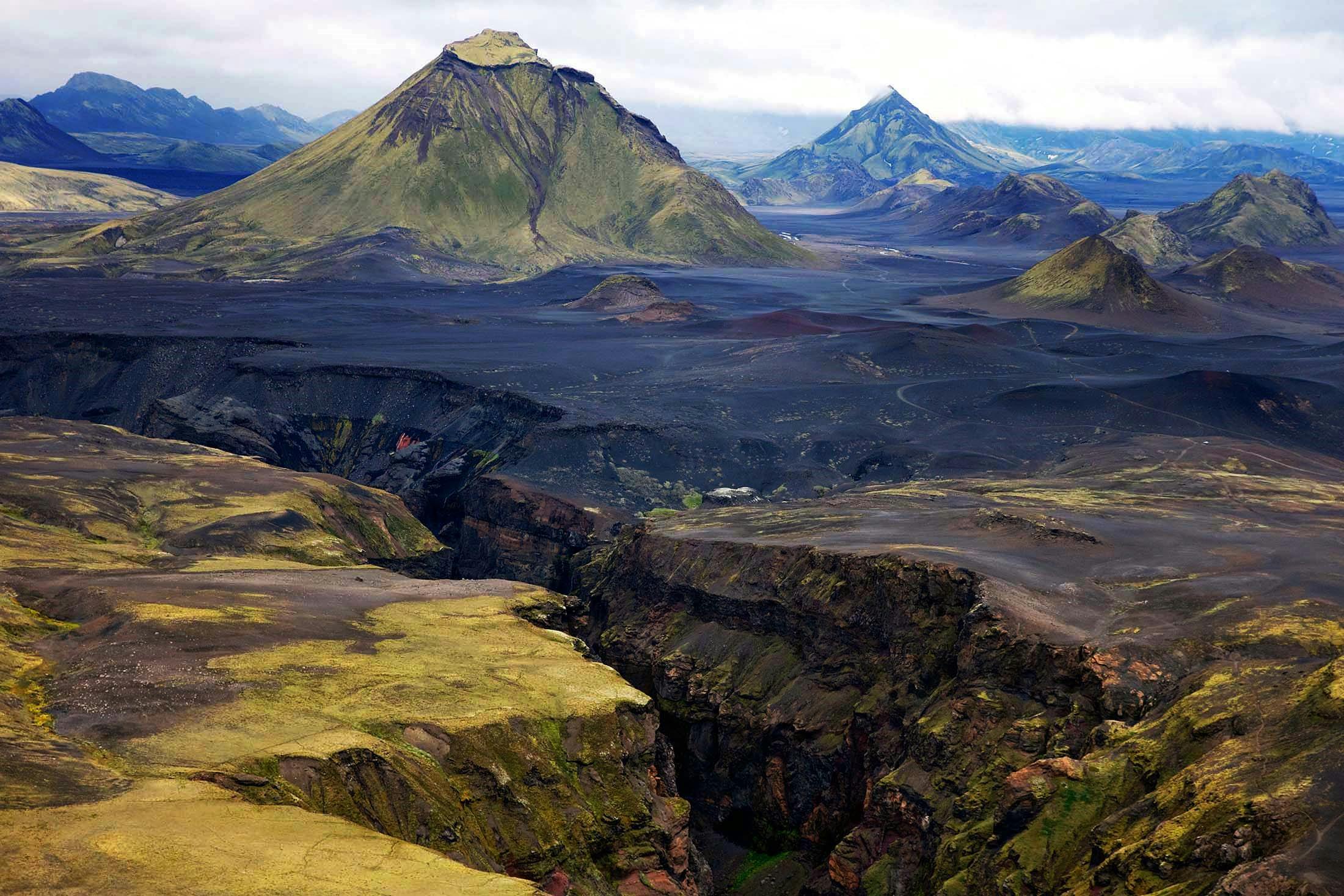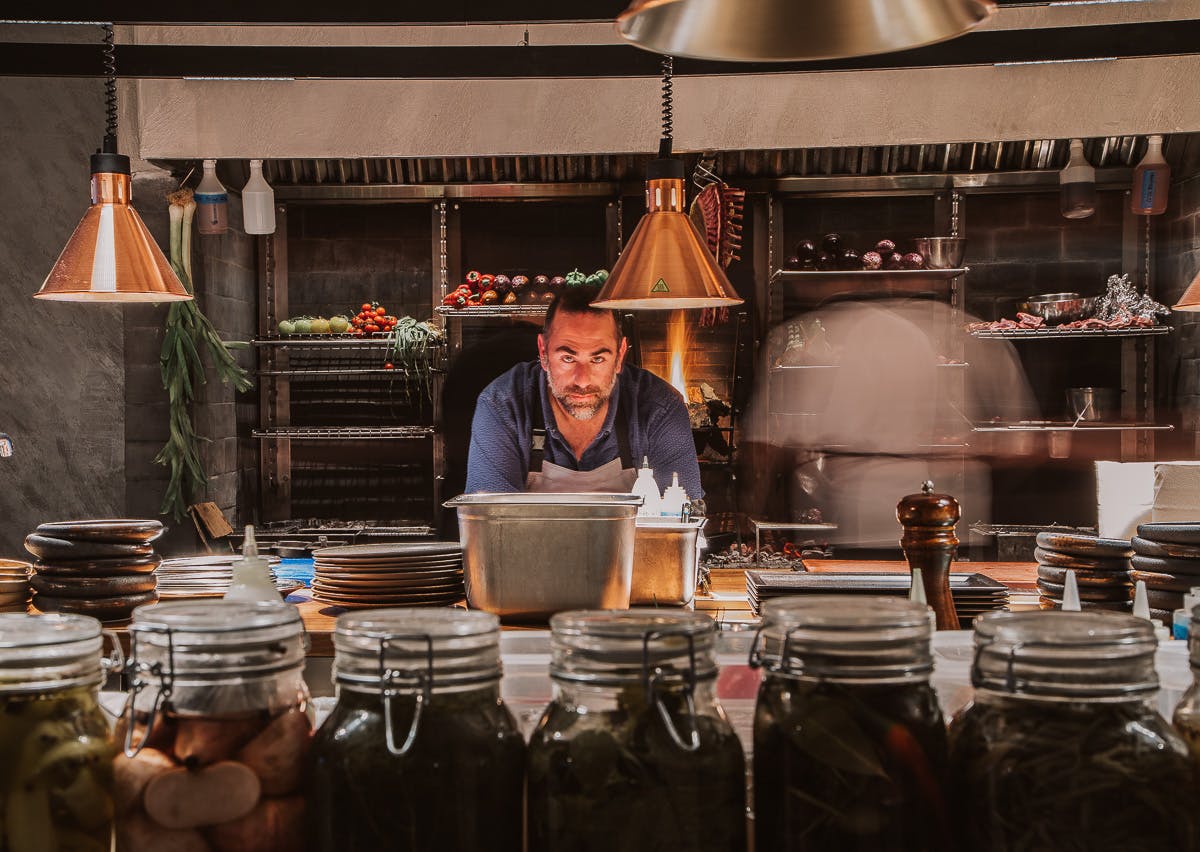S.A.L.T. Lab Radio, Episode 1: Legends of the Border (the Full Transcript)
Welcome to S.A.L.T. Lab radio. I’m Adam Sachs. Food and the culture surrounding it has been my beat for more than 20 years. I love to cook and I live to travel and eat. But what keeps me going isn’t just chasing that next great meal. What I really love is following food to its source and meeting the people preserving culinary traditions, creating new ones and teaching us all how to eat in more well informed ways. On this episode we’ll visit Ana Roš, Mateja Gravner and Antonia Klugmann. Three innovators cooking and making wine along the border of Italy and Slovenia.
Stay tuned to hear what grappling with tradition along that border means to them. From Ana’s quest to bring honor to her ingredients, to the hurdles Mateja’s family faces, to the way Antonia draws influence from her complicated heritage. Plus Trieste’s most celebrated cookbook, ancient wine making techniques, and the worlds most surprising potato. This is S.A.L.T. Lab Radio. –Adam Sachs
If you’d like to read along with the podcast, this transcription is of Adam Sachs’ conversation, on Silversea’s S.A.L.T. Lab Radio, with celebrated Slovenian chef Ana Roš, natural wine pioneers Gravner Wines, and Trieste’s Michelin-star chef Antonia Klugmann.
Visiting Ana Roš, Slovenia’s Star Chef
Mateja Gravner on Sparking the Sparkling Wine Movement
Antonia Klugmann’s L’Argine a Venco Celebrates Trieste’s Crossroads

Ana Roš and Hiša Franko Celebrate Slovenia’s First Michelin Star
Ana Roš:
I’m often asked if my cooking is Slovenian and I always answer that my cooking is not Slovenian; my cooking is extremely regional. The borders have always been moving and along the borders people have been moving even more.
Adam Sachs:
That’s Chef Ana Roš. Along with her husband Valter Kramar, Ana owns and runs two restaurants in Slovenia’s Soča Valley, Hiša Franko and Hiša Polonka. Hiša Franko is elegant, avant garde, and serves a lengthy tasting menu. It’s regarded as the best restaurant in Slovenia. Up the road, Hiša Polonka feels more like a pub, specializing in heartier traditional fare, like the frika we had for lunch. Frika is the local potato pancake. Sharply flavored from an abundance of pork fat and cheese. I loved it and I love the way Ana describes it.
Ana Roš:
Frika is one of the most amazing dishes one can eat. There’s frika in the Italian mountains and Austrian mountains have their variety of frika as well. Originally it was prepared on the open fire in a big pan with a lot of pork fat inside, where they were roasting slowly the potatoes and then finishing it up with the cheese. Then can you imagine this open fire smell and then the melting pork fat and the potato and the cheese.
And honestly, I think that people would be having a source of Schnapps after it because it’s a very heavy dish. But it is prepared for people who are hardworking outside, waking up with cows at 3:00, 4:00 in the morning and then going to bed when the cows go to bed and they are doing the work outside all the time.

And what is beautiful, is that frika today, for young people in the Soča Valley, because of frika on the menu of Polonka became a substitute for pizza. So, young people say, “Let’s go in Polonka to have a beer and have a frika together.” We make sure that tomorrow, our children, our grandchildren will not forget it.
Adam Sachs:
We met up with Ana for two meals. The first, beer and frika. The second, a couple dozen courses at Hiša Franko. We’re just a few miles from the northern Italian region of Friuli Venezia-Giulia. Austria is about 30 minutes by car, Croatia is less than 100 miles away.
“We are very close to the sea. Our mountains and meadows face the Gulf to Trieste. The sea breeze, the north wind is coming. It’s reaching our mountains and the air is salt here. It is changing the minerality of the soil of the plants and this is how the animals that are eating those plants are actually having a completely different flavor. It’s almost sea flavor.”
Ana Roš
Ana Roš:
When you cross the border, it’s not that you’re going into another reality, you actually remain in the same one. So, if you look at my cooking, it is maybe sometimes even closer to the hilly places in Friuli Venezia-Giulia or in the south of Austria than maybe in a place in some other part of Slovenia.
Adam Sachs:
It’s the idea of borders that brought me here in the first place. These lines drawn and claimed on a map can spark controversy, start wars, pull families apart. But what happens to a cuisine when the borders have continuously shifted? The land surrounding Ana’s restaurants, which is stunning, had been contented for centuries. Ostrogoths, Lombards, Romans, Ottomans, Habsburgs, and communists have all wanted control of the turquoise colored rivers, the lush panorama stretching from peak to peak. Slovenia only became a democratic nation in 1991.
Ana’s lineage touches Austria, Romania, and Croatia. Her family lived in Trieste before moving here to the Soča Valley. Growing up in the 70s and 80s, she was a member of the Yugoslavian National Alpine Ski Team and studied to be a diplomat. Sometimes she still sounds like one.
Ana Roš:
When we talk about food I must clearly say that the food doesn’t know the borders. There’s no borders for the food.

Adam Sachs:
Last night at the restaurant we had this amazing dish that involved lamb and crab that was wrapped in Swiss chard. I don’t usually have lamb and crab together. It worked perfectly. It was almost … If you didn’t know there was crab there, you might not pick it out, but in the same way that anchovy can pick up the flavors or enhance the flavors of lamb; it was really beautiful. How did that dish come together?
Ana Roš:
So it’s a wrap of lamb and crab meat. So it’s a pulled lamb with a crab and then it’s all folded in a leaf of Swiss chard. And we serve together a small very clear bowl of the lamb broth that is made out of the other parts of the lamb and inside you have the egg yolk, which is actually emptied and filled with anchovy milk.
I honestly believe that there is always a symbiosis in the nature. If you observe things that are living together in the nature, you can actually imagine you can serve them together.
We are very close to the sea. Our mountains and meadows face the Gulf of Trieste. The sea breeze bora, so the north wind is coming. It’s reaching our mountains and the air is salt here. It is changing the minerality of the soil of the plants and this is how the animals that are eating those plants actually have a completely different flavor. It’s almost sea flavor.
So those lambs in a pasture are overlooking the lagoon where we are getting the crabs from. I mean, you can actually count the fishing boats on the sea. So for me, that trip from the meadow towards the sea combining the crab and lamb, the actual flavor of the meat and of the fish, in this case the crab, is so similar that when I say to people this is lamb and crab they’re like, “Are you nuts? This is never going to work.” And when they eat it they actually find the third flavor because lamb and crab together they actually produce another flavor combination.
Adam Sachs:
And just to be clear, so this is not a traditional pairing? It’s not a Slovenian tradition to put lamb and crab together, but you’re taking things that are features of the landscape, features of the bounty of this area, and finding similarities and, like you say, symbiosis, and making new dishes out of them?
Ana Roš:
People always misunderstand my words when I’m talking about my cooking. And I know a lot of colleagues of mine and a lot of journalists think that we actually are cooking very traditional cuisine, which is not so. When I’m talking about traditions, when I’m talking about the landscape and when I’m talking about the season, I’m talking about product. And I’m talking about the products that come from tradition, like the fermented cottage cheese that is served on our menu together with a potato which is baked in the hay crust.
Adam Sachs:
The story of that dish is incredible. That’s something that I think a perfect example of if you read the dish on paper, it doesn’t sound super promising. A potato wrapped in stuff.
Ana Roš:
We are talking about reproducing an old-fashioned ingredient that no one is using anymore, but I brought it into life in a completely new form. Served with the smoked chocolate and chamomile pollen. That’s something that never happened in a tradition. In a tradition in a mountain area people needed to feed themselves. They didn’t need to… they had no need for fine dining. So what is going on in my kitchen is actually respecting tradition, landscape and the season. They can get a product in their right time. And then my mind is a little bit twisted and so then I twist up the things. But I always create the stories. My food is all about storytelling.
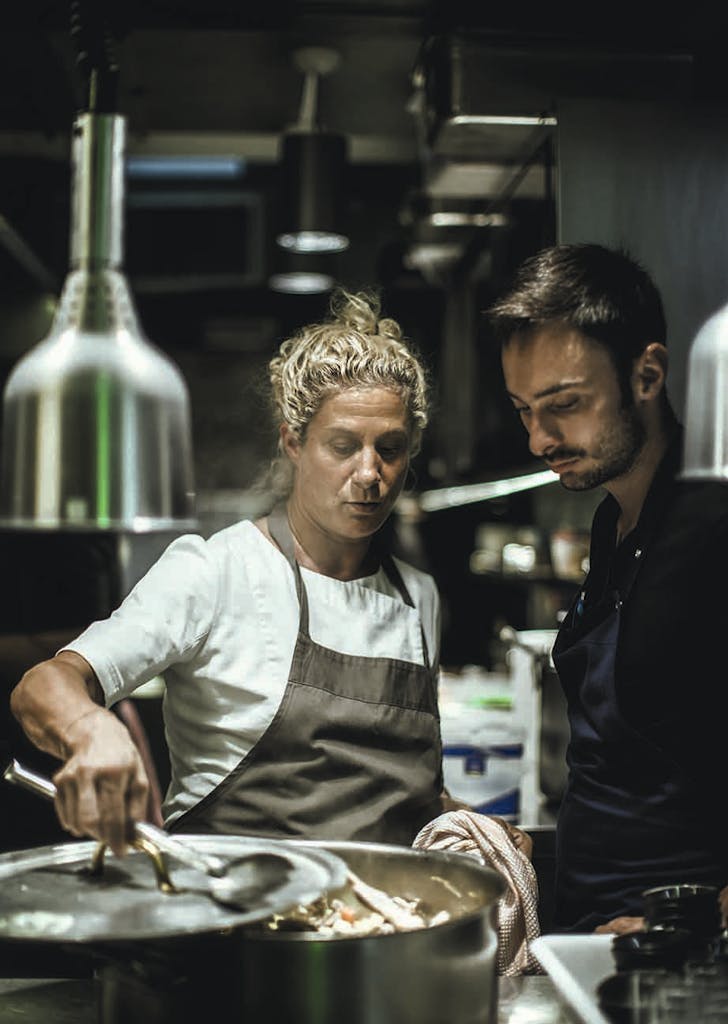
Adam Sachs:
It’s a similar idea to a salt bait fish creating a crust to lock in tenderness. In this case, Ana bakes a potato in shell made from hay. When I cracked mine open, I peeled away the crust and there was this incredibly earthy, rich, deeply fragrant thing inside that tasted more of a potato than just a regular potato. It really blew my mind.
Ana Roš:
I think dining in places like Hiša Franko needs to to be conceptual. So I can serve you amazing caviar or foie gras but you can have that caviar and that foie gras in a prime role wherever around the world.
Adam Sachs:
Right.
Ana Roš:
But I can still use the caviar and the foie gras just to spice up some of our very original ingredients. Potato for me has bigger value than caviar and foie gras. And the potato is Čompe in our dialect and skuta is about the fermented cottage cheese that comes from old, old traditions of cheese making in the high mountains. They ferment it to preserve it and it’s strong and spicy. That is why usually people were eating it with boiled potato without even peeling it.
Now when I wanted to recreate that dish, that is a dish that still families have every day or almost every day for dinner. My children are crazy about it. But how do you produce a fermented cottage cheese and boiled potato? So we were thinking in a very conceptual way saying, “Where is the fermented cottage cheese produced? It is produced in the high mountain. Where did I sleep as a child? In a high mountain.” I slept in a hay house. My first memories of sleeping on hay is actually in the meadows when I was listening to the shepherds with my parents I guess drinking wine and baking frika and me and my sister on the upper floor sleeping on the hay or supposed to sleep. There was a smell of frika that actually you guys tasted yesterday and there was a sound of the shepherds and my parents. And we could smell a fire because frika was made of fire, but we were lying in a bed of hay.
So that is my memory which is so connected to the fermented cottage cheese because in the corner there’s a big bowl where they would put in every day fresh cottage cheese inside pressing the water out and letting it ferment.
So how can I explain to someone what that means? I’m bringing you to the high mountain and the smell is the one. Hay. We don’t eat hay, but we smell hay. So this is why we actually super hydrate the hay and it’s a real hay. It’s not a hay for rabbits. It’s the grass that we cut. And then we powder it and then we mix it with salt and the egg white and we create a crust. And we actually fold the potato in that, wrap it completely. It’s beautiful. It’s like a nori green. And then we let it dry for a few hours and then we bake it in the oven by making little holes in the potato before, so the hay actually penetrates into the potato.
When you actually open the crust the mind wakes up and makes them think they actually are in a high mountain listening to the shepherds and my parents baking frika, but they really are just smelling a potato that is baked in a hay crust.
Adam Sachs:
Oh I think the beauty of that kind of dish is that it works if you know the story, if you hear the story from you, and it works if you just eat it, if you crack it open and you taste it. Maybe you’ve never slept on hay in a high mountain, but something is telling you through your senses that this is earthy and real and different than a regular potato baked in tin foil.
I think you made a great point when you mentioned caviar and foie gras that we have an idea of these things as luxuries, but real luxury I think is coming to a place and eating food that’s really from there and feeling transported by that and then having the extra element of having the storytelling and having the luxury of sort of being in the hands of a chef who can take you places through the food.
Ana Roš:
You wouldn’t believe how much even my colleagues, chefs that read about me, sometimes think that using high mountain products must be very limiting and very boring. What I’m saying is sometimes you should be a lot prouder about what we have around. Do not be ashamed to cook eel. Don’t be ashamed to cook a trout.
When I started cooking, when Italians were coming through the door, they would often be asking me, “So is there any seafood on the menu?” And I would say, “Well no, but we have a trout.” And they would say, “But nobody’s interested in a trout.” Today the trout, like in spring, we had four different courses based on the trout from the trout belly to the trout skin to the trout liver and people usually say that they really (haven’t) had a better fish. So that is the evolution for me.
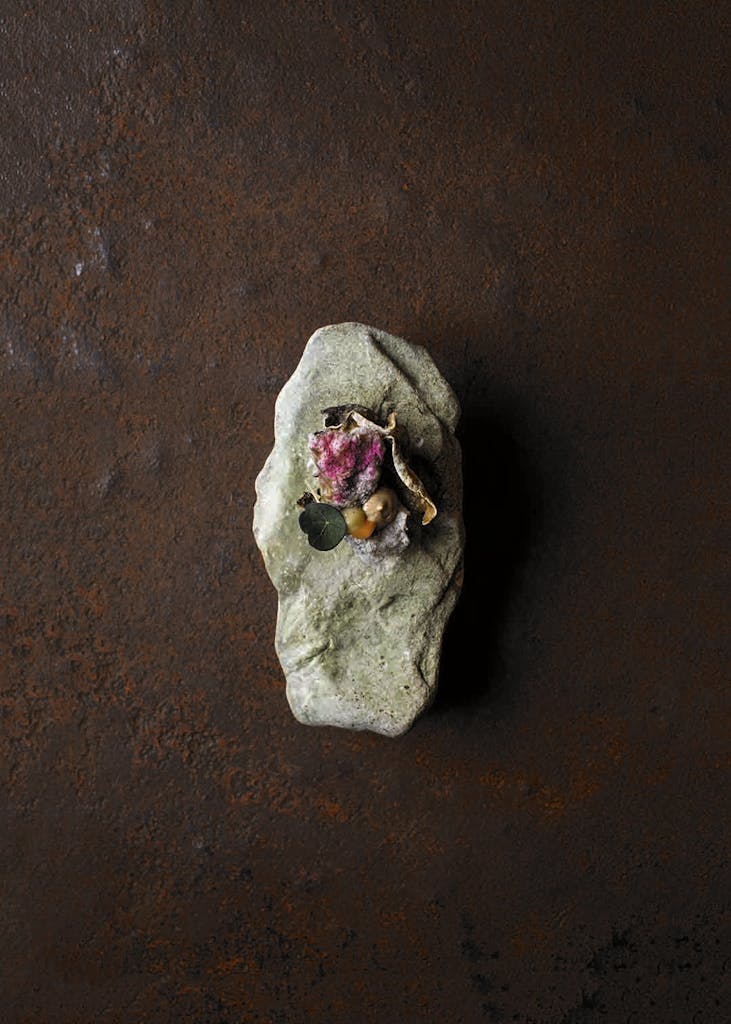
Adam Sachs:
I’ve been here in your region only for about 24 hours and I’ve been introduced to Slovakian wine, to cheeses from the mountain, to salamis made out of bear, to potatoes that taste like the hay in the mountains. So it’s going to be hard to say goodbye to some of these dishes. If you had to describe a few tastes of this region to someone who has never been here, what are a few bites or just a few ingredients that really speak to the taste and the nature of this area?
Ana Roš:
If I have to describe the food in this area in two words only, I would say sweet-sour. Sweet-sour is something that really defines us a lot. You find sweet-sour in Vienna. You find sweet-sour in Trieste. You find sweet-sour in my home.
And sometimes when we serve game with sweet-sour flavors for Italians this is completely out of their mind because they say, “How can I eat meat with a sweet-sour flavor?” But for us combining meat, for example game with sweet-sour flavors, is completely logical. This is how we can finish up the meal with sweet-sour savory flavors respecting the tradition and at the same time telling the story of our places.
Adam Sachs:
At the end of the meal at Hiša Franko Ana served me a dessert I’ll never forget. It was based on a kind of traditional boiled dumpling, but rather than the typical filing of raisins and walnuts this one was filled with apple and pork crackling.
On the side there were sweet dried plums and a creme brule flavored with smoked pork. On top Ana grated horseradish. Remember this is dessert we’re talking about. For me, this one dish really represents Ana’s idea of a bold, borderless cuisine. She pushes the sweet and sour and savory taste of her region to the extreme.
Ana Roš:
Why should I cook always comfort food? Why wouldn’t I risk? So risking in your life is the only way that you make something big. If you play it too comfortable, I honestly think you always remain in a comfort zone, but you’ll never realize something really big in your life.
Mateja Gravner on Sparking the Natural Wine Movement
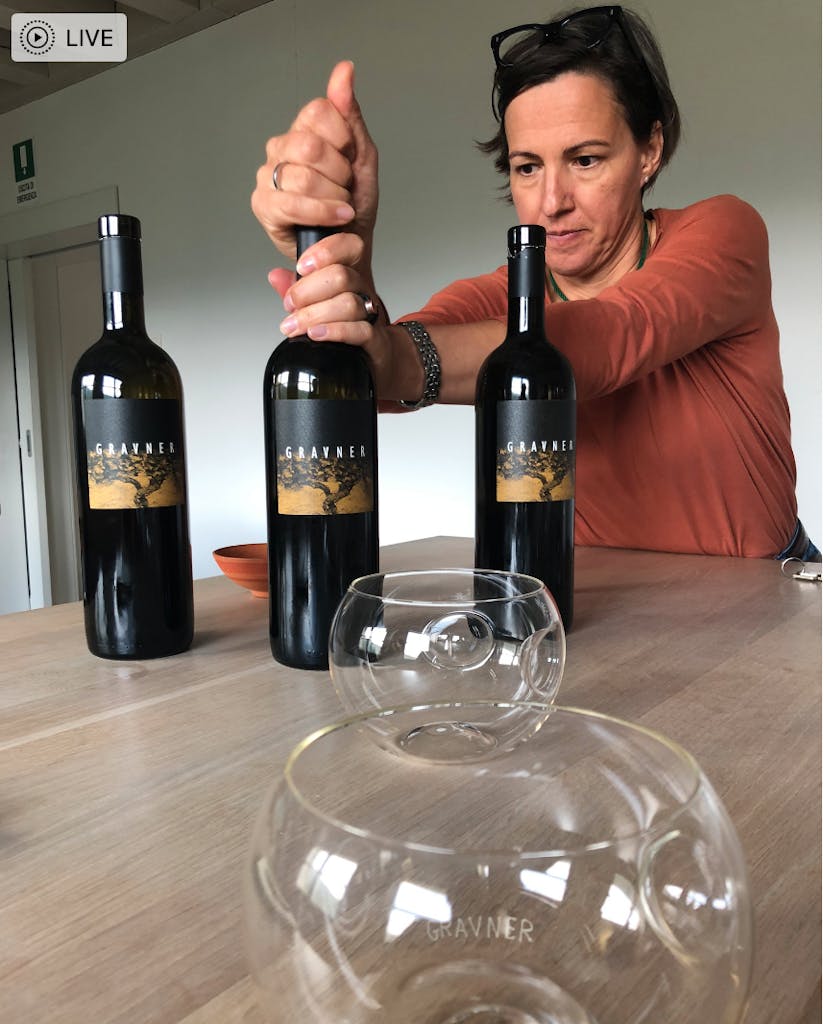
Adam Sachs:
That’s what making wine sounds like at the Gravner Vineyard where the legendary Josko Gravner helps spark the natural wine movement. I’m in their underground amphorae room. More on that in a minute. For now just consider our location. We’re on the Italian side of the border about 35 miles from Hiša Franko. I can see Slovenia from here. It’s almost close enough to smell the dumplings.
Mateja Gravner:
The family name Gravner is actually German.
Adam Sachs:
That’s Mateja Gravner, Josko’s oldest daughter and a big part of the family business. Mateja’s role spans from storytelling to sales to welcoming guests like us.
Mateja Gravner:
But at home we speak Slovene, so we are really a good mix of people. The winery was established in 1901 and at the time we were part of the Austro-Hungarian Empire. After the first war we become part of the Regno d’Italia (Kingdom of Italy) and after the second war the border changed again. Part of our winery, of our vineyard, are on the Italian side, part on the Slovenian. For people who are not so used to cross the border, we cross the border many times a day with absolutely no matter. But for people who are not so used to this often sounds quite strange or funny.
Adam Sachs:
It’s the end of harvest and Mateja shows us around her family’s operation. In the vineyard she points to the towering cypress trees that help protect the vines from the famous bora winds. The bora is the same natural phenomena that Ana says gives her lamb its signature salinity as it whips the salt air from the sea up into the mountains.
Mateja Gravner:
In the mid 90s my father wasn’t any more satisfied about the wine he was making because the wine wasn’t expressing the taste of the grape.
Adam Sachs:
The grape variety she’s talking about? Ribolla.
“We learned that they are not good or bad vintages because they haven’t been made for us humans. We have to be able to deal with them. In every vintage even the most difficult one you can find a good part. I always say it’s like having children. Everyone needs to have an education, but after the basic education you should follow the natural behavior and in order to allow everyone to do it best with his own possibilities. And this is with wine the same.”
Mateja Gravner
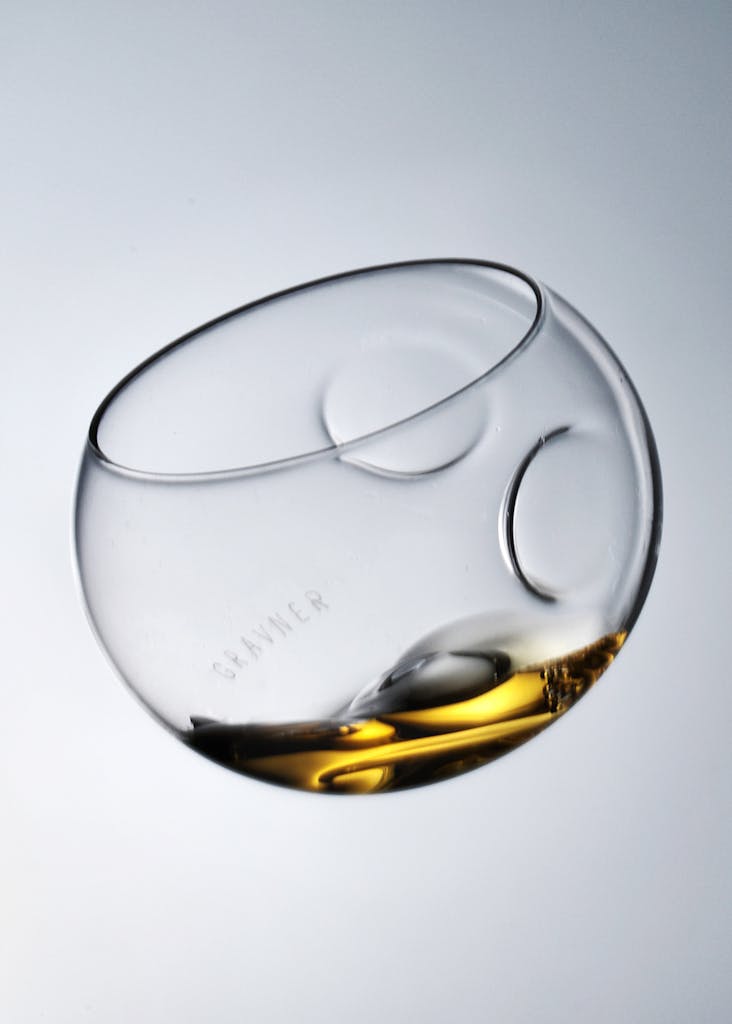
Mateja Gravner:
And this was for us very strange because usually in farming the fruit taste should be the taste you have in the final product. So he started thinking about what was wrong with the ribolla wine production and he started thinking about fermenting ribolla on the skin. Ribolla has a very important skin. It’s a very funny wine grape mainly because the ribolla grape is very crunchy. Not all the wine grapes are so interesting.
Adam Sachs:
Now let’s get back to those amphorae. Amphorae are these giant clay pots imported from the nation of Georgia. They’re buried in the ground to control temperature in a subterranean room that’s cool and damp with a floor made of pebbles. Walking around you have to sort of dodge all these open black holes: the mouths of the amphorae where the wine is fermenting.
We watched workers stirring the grape skins with these big wooden oars pushing them deeper and deeper into the vessels. They do this six times a day to promote skin contact. It’s a slow process. Fermenting can take months or even a year.
Mateja Gravner:
This is the oldest way to produce wine. Some people say it’s more than 5,000 years old. In 2000 my father decided go to visit Georgia. He went there because he wanted to see if there were still people able to make amphorae. At that time there was no market for amphorae. He found some elderly farmers, they were still able to make amphorae. This is a very artisanal way to produce amphorae. It take between two and half, three months, to build each one.
Adam Sachs:
These are fragile vessels. Their walls are thin. Only between three and five centimeters thick. The wine inside each amphora is practically touching the earth surrounding it.
Mateja Gravner:
So my father found this amphorae. He has been able to buy them. We organized shipping. The first one was a real disaster because from 11 amphorae nine arrived completely broken. So we went back and back. It took us five years to collect the 46 amphorae we use in the winery right now.
Adam Sachs:
Like Ana, Mateja Gravner is always thinking about how to balance acceptance and intervention.
Mateja Gravner:
We learned that they are not good or bad vintages because they haven’t been made for us humans. We have to be able to deal with them. In every vintage, even the most difficult one, you can find a good part. I always say it’s like having children. Everyone needs to have an education, but after the basic education you should follow the natural behavior and in order to allow everyone to do it best with his own possibilities. And with wine it’s the same.
Adam Sachs:
Mateja told me that part of working with different vintages and studying them closely is deciding when not to make wine at all. For the Gravners, sometimes the grapes are just not good enough.
Mateja Gravner:
Even you want to be even stricter there is no reason to produce just average quality wines. If the grapes are not good enough, we don’t make it. And once you start thinking this way and you get really concentrated about quality, everything else becomes really not so important.
We believe that everything you do has to be made in the right way in order to be important. There are not important jobs or less important or not so important jobs. Everything you do, if you do it in the proper way, in the best way you are able, becomes important.
Adam Sachs:
Ana, Valter, Josko, Mateja, they’re all making extraordinary choices to slow things down.
Mateja Gravner:
We’re always in a hurry, but there are things you can’t hurry. You can start going to school earlier, but this doesn’t mean you will be adult earlier. You can not hurry the nature. The nature has its own rules and you have to accept them. Once you accept them, so once you stop fighting against things you can’t change, the perspective of life will become completely different.
Adam Sachs:
It seemed only right to leave Gravner with a drink and a toast.
Mateja Gravner:
Živjo is a Slovene word which means, it’s closest to santé in French, but živjo means “to the life.” And even a toast to the life, which a toast should be. It’s a luxury, but I think we should every single day remember that we have to toast to our own life to preserve it and to make it better tomorrow. Živjo!
Adam Sachs:
After enjoying the 2010 and 2011 vintages at Gravner both nectar-like and the color of sherry, we drove 30 minutes to Collio Goriziano. It’s in Italy, but to get there from Gravner we crossed the border a few more times, which felt to me like a subtle thrill.
Antonia Klugmann’s L’Argine a Vencò Celebrates Trieste’s Crossroads
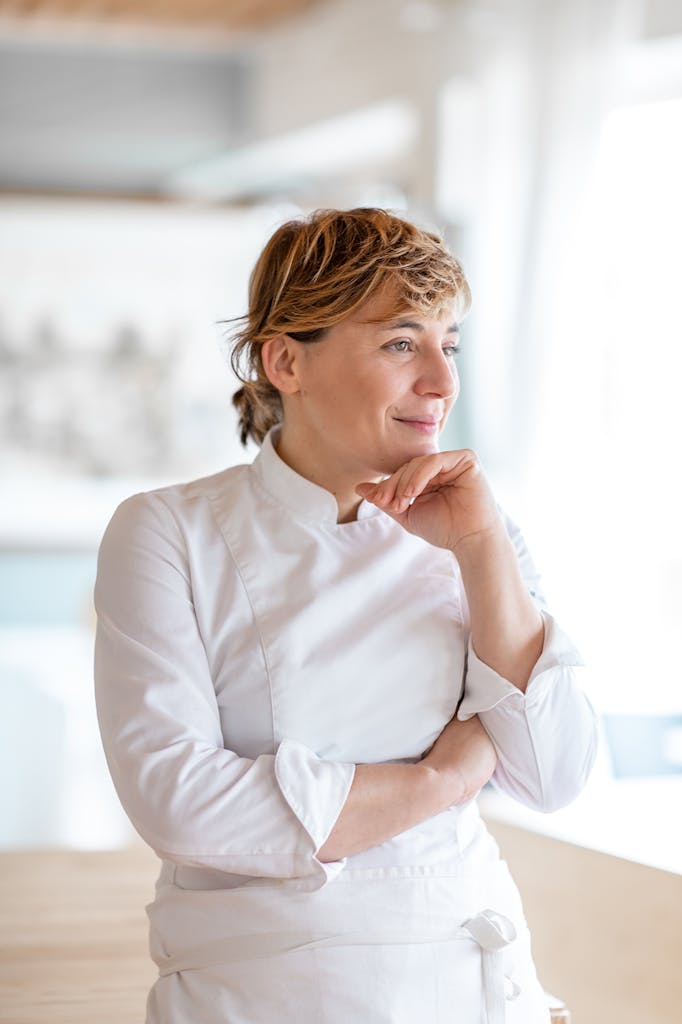
Adam Sachs:
In Collio we were welcomed by chef Antonia Klugmann at her Michelin-starred restaurant L’Argine a Vencò. It’s a modern, minimalist building the color of sage. Antonia set out an unforgettable lunch: bread fresh from the oven, five kind of cheese from local producers, homemade sweet and savory jams, and lardo, pancetta, and prosciutto from just up the road.
Antonia’s dinner menu is far less rustic. Just like Ana she plays with the idea of pairing sweet and savory together like her gnocchi with red plums, turnips, and rose petals.
And you’re from Trieste? You grew up in Trieste?
Antonia Klugmann:
Yes, I come from Trieste.
Adam Sachs:
Well, it’s a little more complicated than that. Her family has Polish, Russian, and Southern Italian roots. Parts of her family hid from Nazis, others held fascist beliefs. Antonia says most Italians don’t even understand what a melting pot Trieste really is.
To understand her cooking you need to understand where she comes from. A city that was the main port of the Austro-Hungarian empire. A city that after World War II became the edge of the Western world jolted by the presence of the iron curtain. A city that was occupied by American and British forces. A city to which the world was drawn and where outside influence remains vast.
So maybe tell me a little bit about what does it mean to cook in this region, to cook as someone who grew up in Trieste who’s Italian but comes from many different backgrounds, to cook this close to the border. How does that inform what you do? How does that inform what you grow, what kinds of dishes you make?
Antonia Klugmann:
Yes, well when I bought this place, first of all, I wanted a place in the countryside and I wanted it to be beautiful, surrounded by beauty, because I think beauty is such a great origin for creativity. And I’ve chosen this part of the Friuli region because it’s quite similar culturally from my city because Trieste was for 600 years under the Austrian Empire and a lot of cultures where there as my family can represent perfectly.

Adam Sachs:
Where are the different parts of your family from?
Antonia Klugmann:
Yes, we are a mix. So my grandfather was Jewish and while he was hiding from the Nazi in the Emilia-Romagna he met his wife, Ferrarese, from Ferrara. The other part my grandfather came from Puglia, the south of Italy.
Adam Sachs:
Far south, yeah.
Antonia Klugmann:
So that south of Italy. And then my grandmother came from Trieste. So really a mix.
Adam Sachs:
And is that typical of people in Trieste?
Antonia Klugmann:
Yes.
Adam Sachs:
Even now that their family background is a patchwork like that?
Antonia Klugmann:
Yes. Yes, we are lucky in many ways because of the port. A lot of different cultures as in Venice united in strange ways because family and mix that you create naturally. Mix in culture in a family is the way that the layers can play in the most beautiful way. So Croatian, Serbian, Greek, British.
Adam Sachs:
Really?
Antonia Klugmann:
Yes, British.
Adam Sachs:
Why? What do they bring? The tea. I’m having tea.
Antonia Klugmann:
No, but even the chorus.
“Yes. I listen to people when they talk about food. It’s so interesting for me and it really moves me in a way. Even watching movies about food it changed me. Even if I see a fragment of a photo where a cook cooks something that I don’t know, it changes me. I’m like a sponge in my kitchen. And really the kitchens are a place for freedom. No borders are in the kitchen. And this is my mantra.”
Antonia Klugmann
Adam Sachs:
Antonia is talking about singing with an Anglican chorus as a kid. She didn’t grow up religious, but still sang in church with her English kindergarten teacher.
Antonia Klugmann:
I used to go with some of my friends who are British to their chorus during the wintertime and they influenced me in some way with the lamb, with the mint, and the Christmas pie. Yes, they were amazing for me. And I drink a lot of tea with milk.
Adam Sachs:
Okay.
Antonia Klugmann:
Yes, like black tea.
Adam Sachs:
You’ve become quite British.
Antonia Klugmann:
Yeah.
Adam Sachs:
Very proper. So cooking in a way and thinking about food in a way that crosses borders comes naturally for you. It’s not a thought you bring to thinking about being near the border and you have to cook a certain way. It’s just who you are.
Antonia Klugmann:
Yes, exactly. It’s something natural. Totally natural. And I’m really proud of that because usually in Italy in some regions that are very, very rich of ingredients and cultures and they are really rooted to their origins, they don’t have this mixed, you know? I have both because of my parents.
Adam Sachs:
Right.
Antonia Klugmann:
And so, I’m so lucky, you know?
Adam Sachs:
It is. I think this is one thing at least for American travelers and diners that we are always told that the food of Italy is very regional. You don’t eat one thing in the south that you would eat in the north or it’s fresh pasta in the north and dry pasta wherever.
Antonia Klugmann:
Yes.
Adam Sachs:
But there’s much more nuance to it when you come to a place like Trieste or this region where there are many more influences other than just the specifics of what’s there.
Antonia Klugmann:
Yes, exactly.
Adam Sachs:
It must liberate you because you don’t have to cook something that is just what you grew up with or your parents made for you.
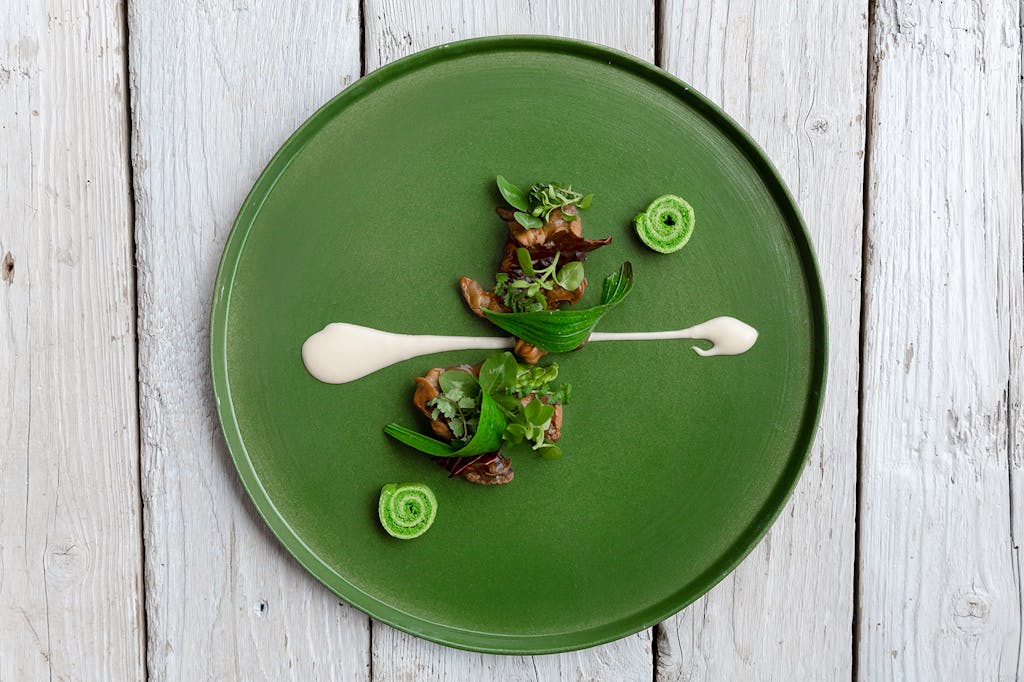
Antonia Klugmann:
Yes. I listen to people when they talk about food. It’s so interesting for me and it really moves me in a way. Even watching movies about food, it changed me. Even if I see a fragment of a photo where a cook cooks something that I don’t know, it changes me. I’m like a sponge in my kitchen. And really the kitchens are a place for freedom. No borders are in the kitchen. And this is my mantra.
Adam Sachs:
We just had a lovely lunch where we had a little bit of local ham and beautiful cheeses. And then afterwards you were showing me the herbs that came from the garden that you and the chefs go and collect, some of them wild, some of them planted. You’re making really fascinating vinegars out of unusual ingredients. So you’re taking these things and applying your creativity to them and being inspired by them. Talk about some of those things that inform your cuisine.
Antonia Klugmann:
Yes. I think it’s quite intense to live in the countryside because as a cook you have a direct experience to ingredients in a way. So you have to listen to them to the season in a real way and in your personal way. As I said to you, for example, you can perceive that immediately looking at the trees and nature outside restaurant that tomatoes, peaches, and apricots they are cousins. And applying the techniques that you know for sweetness and for sweet candy that to tomatoes it’s quite natural if you observe them in nature.
Adam Sachs:
This is a tomato jam or compote that you made?
Antonia Klugmann:
Yes. For example, I do jam with the tomatoes, but also I do a lot of sweet preparation from them.
Adam Sachs:
Preserving them.
Antonia Klugmann:
Yes, preserving them in different ways. But having so many fruit trees you have also to wonder how you can preserve them because they are so many. And you have to use your minds in different ways making juices and vinegar was a way to use them. Not wasting the fruit. And so, this year I started making vinegar from the tomatoes during the season, red tomatoes and yellow ones, but also from the persimmons, from the cherries, from the figs, from whatever.
Adam Sachs:
Amazing. And this is not traditional to the region. This is a place of persimmon vinegars. This is —
Antonia Klugmann:
No, no at all. We usually make vinegar, very, very good vinegar from the grapes because this is a vineyard zone. So we, of course, make a lot of vinegar from that. And traditionally we use the apples to makes the vinegar. Yes, it’s a new way to use fruit.
Adam Sachs:
So is that freedom for a chef to be able to apply traditional techniques, things that you know work, and transform ingredients into something else that can sort of outlast the season and go beyond the season, but apply it to things you see around you in ways that haven’t been done before?
Antonia Klugmann:
Yes, that is so interesting because nature…
Adam Sachs:
It’s time more than energy.
Antonia Klugmann:
Yes, time. Time. Of course, that has a value. But you don’t do anything as a cook. You only put the ingredients together and nature alone it does the magic. It makes the magic.
Adam Sachs:
Yeah. It’s like wine making. It’s applying culture and knowledge and experience to nature and letting it do its magic with as little intervention as possible.
Antonia Klugmann:
Yes.
Adam Sachs:
Who were the cooks in your family? Who were your role models in the kitchen?
Antonia Klugmann:
Well, I experienced those two branches of my family totally differently in a way. We had this Austro-Hungarian tradition from the Jewish family with some beautiful things from Emilia-Romagna. So fresh pasta, a fritto misto all’italiana, and a typical center Italian tradition.
And the other part … And so my granny used to cook in that family and my nonna Marisa who gives me the recipes for my cakes, for the breakfast here. And my traditional Triestini behavior in the kitchen are totally from that part of the family. And the other I had my grandfather Antonio from Puglia and he was a great cook in my opinion, but he died when I was young, when I was 10. But I have so many memories from him. The anchovy from the fish market. We used to take them home and eat them raw with a little bit of lemon and salt and olive oil.
And he was such a great cook. Really, a great cook. And even Triglie alla Livornese, red mullet cooked with a fresh tomato sauce and a little bit of oregano on the top and that’s it. Very good. And then, his pizza. I can remember the traditional use of cheese at the end of the meal. No desert, only cheese at the end.
Adam Sachs:
Always a cheese course?
Antonia Klugmann:
Yes, always.
Adam Sachs:
Very proper.
Antonia Klugmann:
Yes.
Adam Sachs:
So you had these influences. You saw great food or you were exposed at a young age to great food.
Antonia Klugmann:
Yes.
Adam Sachs:
And you come from a place with all these overlapping culinary traditions. But your path to being a chef was not direct. You were planning on being something else.
Antonia Klugmann:
Yes, because in my family they are all medical doctors…
Adam Sachs:
Okay.
Antonia Klugmann:
…and it’s totally normal and proper to study at the university and have a proper job in my family. That being a chef was totally not in the mold.
Adam Sachs:
Not in the plan.
Antonia Klugmann:
Not in the plan. And I used to study to become a lawyer in my university in Milano when I had this strange phone call to my parents separately because they are divorced. One was in Milano and one was in Trieste. I call them and I said to them, “I’m so sorry. I really would like to be a cook.” And they were like a little bit afraid and frightened for me.
Adam Sachs:
Was there silence on the other end of the phone?
Antonia Klugmann:
Yeah, silence.
Adam Sachs:
Yeah.
Antonia Klugmann:
A lot of silence.
Adam Sachs:
Judgemental silence.
Antonia Klugmann:
But at the end they … It was like 18, 19 years ago. It was not so fashionable being a chef. And so my mother said to me this beautiful sentence. She said to me, “You have to earn money in your life. And there will be always a place for a cook in the world.” So she was really worried for me in a way.
And she never thought about me as a creative chef, a fashionable chef. And during the years she was I think surprised about how my career went, in a way. I think I am a creative person and law wasn’t a good fit for me, but in the end the power to change everything was how my life was going. So I was really sad because my boyfriend left me.
Adam Sachs:
Oh no.
Antonia Klugmann:
Yes, because my parents get divorced.
Adam Sachs:
Oh no.
Antonia Klugmann:
Yes, and I was…
Adam Sachs:
It’s a lot.
Antonia Klugmann:
…really good at the university because I think I’m not so stupid. I was really good. And the problem was that I was really a little girl even in my elementary school really conscious about how short life is.
Adam Sachs:
Really?
Antonia Klugmann:
Really, really conscious about that. I’m really frightened about dying, the stuff about dying, the end of everything, and so I always push. I always go really fast because of that. And in that occasion I thought, “Wow, I have to change everything because I want to be really happy in my life and do what I love.” And what I loved was food. So I changed everything to work with food.
Adam Sachs:
We were talking about a book that had a profound influence on your cuisine.

Antonia Klugmann:
Yes, Maria Stelvio. Yes, this is…
Adam Sachs:
Who is Maria Stelvio? And tell me about her book and what it means to you.
Antonia Klugmann:
Yes, Maria Stelvio during the 20s, at the end of the 20s in Trieste she wrote this beautiful recipe book. I collect the different editions. And she couldn’t sign the book with her name. Maria Stelvio isn’t her real name. The interesting thing was that she was married. She married three times. She had a beautiful and adventurous life and she collected all those recipes from Trieste that were never published in this way.
So in this book you can find recipes from Mediterranean countries because Trieste was a port and a lot of crusade boats arrived there. They built the boats in Trieste. And so, so many cooks, professional cooks arrived there from all over Europe. And she collected all these amazing recipes with a really … in a modern way, really modern way.
Adam Sachs:
Who was she writing for? Was she writing for other chefs or for home cooks?
Antonia Klugmann:
For home cooks.
Adam Sachs:
Okay.
Antonia Klugmann:
Women. But because of the quality of her work this book became the base for the city culture because of all those incredible influences. Even a family like mine could find recipes that were good for every member. In her book you can find recipes from Puglia, from Eastern Europe, from Serbian and Croatia and Balkan countries, all in one book.
Adam Sachs:
And this is a book that was written in the 1920s and showed and sort of celebrated the diversity of the city in that way.
Antonia Klugmann:
Exactly.
Adam Sachs:
And it must have hit a note. I mean, if it came … It had many editions.
Antonia Klugmann:
Yes, I have a…
Adam Sachs:
This was something that spoke to the people of Trieste.
Antonia Klugmann:
Yes, every family has at least one book from Maria Stelvio because the point is that every generation gave a book to the next one.
Adam Sachs:
Okay.
Antonia Klugmann:
So I have the one from my mother from the 70s, but I have also the first edition because I’m a chef, of course, and I bought it.
Adam Sachs:
And is that patchwork or that sort of diverse cuisine that Maria Stelvio was writing about in the 20s is that the food of Trieste today?
Antonia Klugmann:
In a way, yes. The amazing thing about the city is that this layering process is totally natural. So that is how deep is the culture in my city that is interesting. Because it’s not something that is…. It’s not a modern fusion, you know?
Adam Sachs:
Right. Yeah.
Antonia Klugmann:
Everything applied one on the other. But it’s a layering process. Six hundred years of layering.
Adam Sachs:
And what about the sort of sweet, sour influence of Austria or going north a little bit?
Antonia Klugmann:
Okay. We really have a lot of fruit in our countryside, a lot of varieties, but we have also the sea. And we have also the cows, the pigs. So it’s quite usual to put the fruit in savory dish. And maybe fresh fruit but also preserved fruit.
Antonia Klugmann:
And that’s why I’m working so much in my cuisine with the fruit in a strange way. For the rest of Italy it may be a strange way, but for our Austro-Hungarian it’s fits quite in the mood.
Adam Sachs:
It makes perfect sense. So yeah, you say strange. Is it strange … If I’m from Rome and I come to your restaurant, is this … I don’t know what the fruit is doing on the plate next to the fish or the pork?
Antonia Klugmann:
Yes, yes. It’s totally original for a Romano, yes. Yes. I make those beetroot gnocchi with the plum jelly and the skins fried of the Jerusalem artichoke. And I make this beetroot gnocchi because, of course, my origins because in Trieste we have this gnocchi filled with fresh plums.
Adam Sachs:
Remember Ana’s dumplings at Hiša Franko? This is Antonia’s version. She’s Italian so it’s gnocchi to her.
Antonia Klugmann:
Inside you fill them with plums or cherries in the season…
Adam Sachs:
Wow.
Antonia Klugmann:
… and you use this type of gnocchi as a contorno of meat, veal for example, or you can eat them as a desert with a little bit of sugar on the top and cinnamon or you can use it with a little bit of Parmesan on the top and butter. And as you see, you don’t know if you are in the sweet world and savory world.
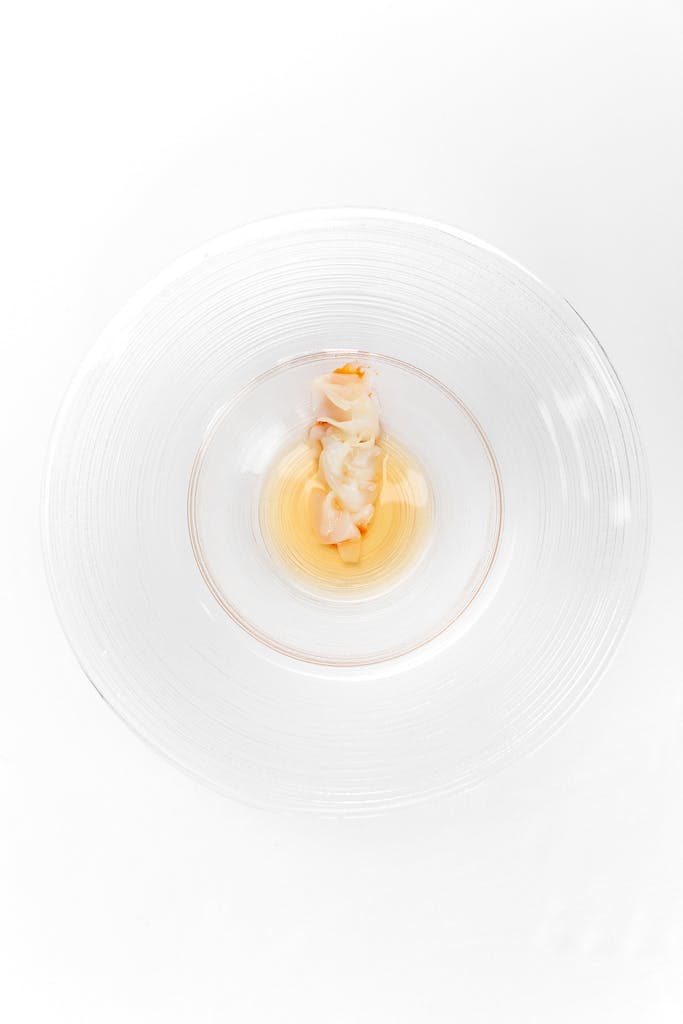
Adam Sachs:
You’re in a delicious world. That sounds amazing.
Antonia Klugmann:
And in a way this is all for my happiness.
Adam Sachs:
We’re all here for your happiness.
Antonia Klugmann:
Yes, this is it.
Adam Sachs:
What does it mean to cook border cuisine?
Antonia Klugmann:
I think there is no definition, no strict definition for that because it’s really related to who I am as a citizen of Trieste. For me, it’s like a bridge. It’s not something that closes, but it’s a bridge to something else.
Adam Sachs:
I really love spending time in this fascinating border region eating and talking with Ana, Mateja, and Antonia. Ana’s food read like a Slovenian folktale filled with surprising twists and real wisdom. Mateja’s thoughts on wine sounded like a lesson on how to live your life. And Antonia’s personal and joyous cooking sheds light on a complex region.
Thanks so much for joining us on S.A.L.T Lab Radio. Come back next time. We’re going to Albania.
Curious to learn more about Ana, Mateja and Antonia?
- Ana Roš: Ana’s Hisa Franko recently was the first restaurant in Slovenia to be honored by the Michelin Guide, and it received two stars. Ana’s new book, Sun and Rain, is published by Phaidon Press.
- Plan a visit to Gravner Winery and explore Ribolla and amphorae.
- If you can’t make it to L’Argine a Vencò, you can follow Antonia’s adventures and watch her dishes come together on Instagram @AntoniaKlugmann.
Adam Sachs:
S.A.L.T Lab Radio is produced for Silversea Cruises by Rob Corso, Casey Kahn and Howie Kahn at Free Time Media, and Adam Sachs. Episode music by John Pahmer. Special thanks to Ana Roš, Mateja Gravner, Antonia Klugmann, Barbara Muckermann, Barbara Biffi, Elena Moriondo, Vittoria Klugmann, Marko Kovack, Valter Kramar, Manca Intinič, Josko Gravner, Vivian Matos, Sheila Donnelly, Evyn Block, and Tom Camuso.
I’m your host Adam Sachs and I’ve got a craving for dumplings.
S.A.L.T Lab Radio is brought to you by Silversea Cruises. With more than 1,000 destinations over seven continents, including exclusive culinary adventures on the all new Silver Moon, Silversea travels deeper.






